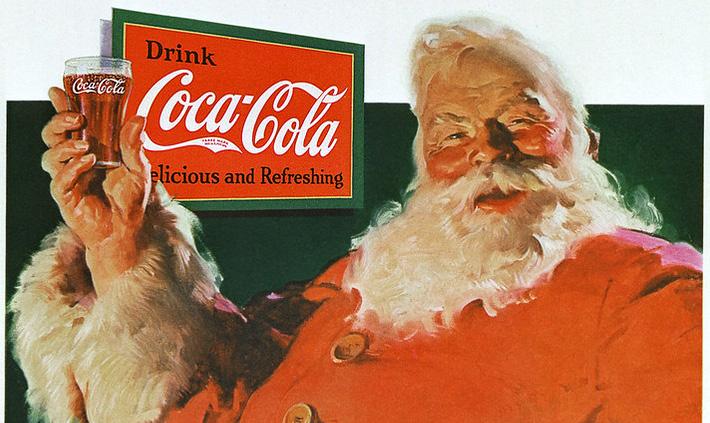
4 minute read
How The Consumer Stole Christmas
by ELIZABETH GOTTMANN
The word “Christmas” literally means “Christ’s Mass”. It originated as a celebration of the birth of Jesus Christ, a birth that many still celebrate today. What Christmas has come to mean however, is much different. How the birth of Jesus Christ became a secularized celebration of spending can be explained through a rapid progress of marketability and consumer spending combined with the adaptation of Pagan symbols and Dutch folk tales. How this evolution shifted the holiday was surely a complicated and tedious process, but there are some specific changes that occurred that can be seen as landmarks of this Christmas transformation.
Advertisement
One may assume that Christmas has always been a celebration that has taken place in the United States, this though is very untrue. The U.S. became a sovereign nation in 1776 after the signing of the Declaration of Independence; Christmas did not become a national holiday until president Ulysses S. Grant declared it so in 1870, about one hundred years later. Christmas traditions however, had been brought over by Europeans many years prior. In Europe, the folk tales of a Sinterklaas had been told for a long time. He would ride in on a horse and visit houses, children would leave carrots in their shoes for Sinterklaas’s horses to enjoy and he would
An onlooker watches a Ronald McDonald balloon at the Macy’s Thanksgiving Day Parade, which kicks off the Christmas season in the United States. ”A sense of wonder at the Macy Parade” by terryballard is licensed under CC BY 2.0 and has been cropped.
leave presents (mainly some No more horses either, magikind of candy) in the shoes in cal reindeer added to fantasy. return. Sinterklaas was also When Santa reached the U.S., said to have a group of playful however, his image was still of a helpers. When Christianity thin, basic looking man. Images reached the Netherlands, of Saint Nicolas, too, were of a Sinterklaas’s folk tale was statuesque bishop who didn’t celebrated and associated always wear a red robe. Our with the bishop Saint Nicolas. modern image of Santa came Saint Nicolas was said to have to be the same way many of left money in the chimneys of our modern images are generwomen who were without a ated, through artists. dowry, which was essential in marriage arrangements at the In the 20th century, as writers time. These tales combined and artists such as Washington and created America’s mod- Irving, Clement Clark Moore, ern Santa Claus. A man with Thomas Nast, and Katherine a group of elf helpers that Lee Bates began to artisticalbrought presents to children ly create Santa’s home, wife, through a chimney. Instead workshop and overall story, one of the carrots for the horse, man would cement the image it became cookies for Santa. of Santa into our minds forev26
er. Haddon Sundblom would create the image of Santa Claus we know today to be used as a marketing campaign for Coca-Cola. The friendly, plump and jolly face was seen enjoying a Coke. Wearing a red coat with white trim (Coca-Cola’s trademark colors). Coke sales sky rocketed and it did not take long for more companies to jump on the bandwagon. Soon images of Santa were everywhere. The epicenter of this Christmas market was New York and for good reason. New York, formerly named New Amsterdam when it was first settled by the Dutch, was engulfed in Dutch traditions and folklore. Most importantly, Sinterklaas, the model for the modern Santa Claus. Big stores like Gimbel began having Santa characters taking requests from eager children as their those not wishing to partake parents shopped. Santa be- in a religious celebration. came the grand finale in Messages that encourage the Macy’s Thanksgiving Day time spent with family, charity Parade. Things such as the and peace are told through Yule log, Christmas tree, and the lens of Christmas; it has mistletoe began to become become a time of family and symbols for the season, tra- friend togetherness, regardditions also brought over by less of religious affiliation. the Dutch and other Europe- Those wishing to celebrate an nations. Soon a medley of Christmas in a more traditionsecularized carols and Christ- al, religious way still do so. A mas specials became season main success that Christmas staples. Before long, everyone accomplishes is bringing peohad somebody to celebrate ple together in a loving and on Christmas, and it was not joyous way. It is a time for all (necessarily) Jesus Christ. people to come together and The transformation of Christ- nect us. The joy of Christmas mas into a more secular time is a transcendent feeling consumer holiday is not all that, even with a little bit of negative, though! In pres- marketing coercion many are ent-day America, many of proud to celebrate. the messages associated with Christmas are accessible to bask in the things that con-











